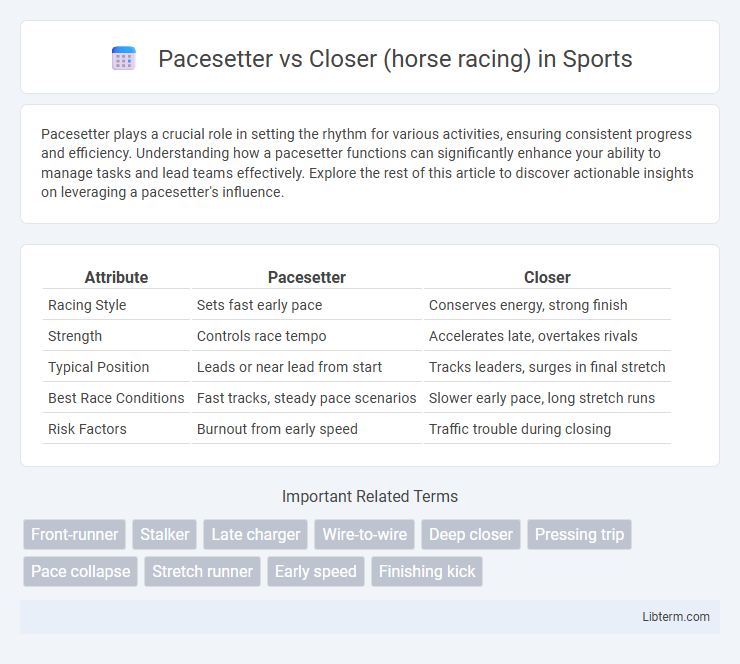Pacesetter plays a crucial role in setting the rhythm for various activities, ensuring consistent progress and efficiency. Understanding how a pacesetter functions can significantly enhance your ability to manage tasks and lead teams effectively. Explore the rest of this article to discover actionable insights on leveraging a pacesetter's influence.
Table of Comparison
| Attribute | Pacesetter | Closer |
|---|---|---|
| Racing Style | Sets fast early pace | Conserves energy, strong finish |
| Strength | Controls race tempo | Accelerates late, overtakes rivals |
| Typical Position | Leads or near lead from start | Tracks leaders, surges in final stretch |
| Best Race Conditions | Fast tracks, steady pace scenarios | Slower early pace, long stretch runs |
| Risk Factors | Burnout from early speed | Traffic trouble during closing |
Understanding Pacesetter and Closer Roles in Horse Racing
Pacesetters in horse racing lead the field by setting a fast early tempo to control the race dynamics, often forcing other horses to expend energy prematurely. Closers conserve energy in the early stages, relying on a strong finishing kick to overtake tiring rivals in the final stretch. Understanding these roles is crucial for race strategy, as track conditions and competition can determine whether a front-runner or late charger has the advantage.
Key Characteristics of Pacesetters
Pacesetters in horse racing are known for their speed and ability to maintain a fast tempo from the start, aiming to control the race's pace and tire out competitors. They possess high early speed, strong stamina, and the tactical awareness to set an aggressive but sustainable lead. Successful pacesetters often leverage front-running strategies, exploiting clear tracks and avoiding traffic to maximize their chances of winning.
Key Characteristics of Closers
Closers in horse racing are known for their strong finishing speed, often staying behind the pack during the early and middle stages of a race before accelerating powerfully in the final stretch. They possess exceptional stamina and tactical patience, conserving energy to execute a decisive late run. This strategy relies heavily on race pace dynamics and track conditions, with closers excelling in races where early leaders set a fast pace that tires them out.
Race Strategy: Pacesetter vs Closer
Pacesetters in horse racing aim to lead early, setting a fast and consistent tempo to control the race pace and tire out rivals. Closers conserve energy near the back of the pack, relying on a strong finishing kick to overtake tiring horses in the final stretch. Effective race strategy balances track conditions, pace setup, and the horses' stamina profiles to maximize positioning advantage.
Ideal Race Conditions for Pacesetters
Pacesetters excel in races with fast tracks and relatively short distances, where maintaining a strong, consistent pace upfront is crucial. Ideal race conditions include dry weather and firm turf or dirt surfaces, allowing these horses to capitalize on early speed without expending excess energy. Races with moderate field sizes help pacesetters avoid early traffic congestion, improving their chances to control the pace and secure a favorable position.
Ideal Race Conditions for Closers
Closers in horse racing excel on tracks with a fast pace that allows front-runners to tire early, creating ideal conditions for a powerful late surge. Courses with longer homestretch lengths favor closers by providing ample space to gain ground and overtake competitors. Races run on firm or fast turf and dirt surfaces enhance a closer's ability to maintain momentum during their final drive.
Famous Pacesetters in Horse Racing History
Famous pacesetters in horse racing history include Secretariat, known for setting early fast fractions that often led to dominant victories, and Zenyatta, who frequently dictated a strong pace to control the race dynamics. These horses exemplify the strategic advantage of maintaining a leading position, leveraging speed and endurance to outlast competitors. Their ability to set a challenging tempo influenced race outcomes and established benchmarks for future pacesetters.
Famous Closers in Horse Racing History
Famous closers in horse racing history exhibit extraordinary acceleration in the final stretch, turning seemingly lost races into iconic victories. Legendary horses such as Secretariat, Zenyatta, and California Chrome demonstrated remarkable closing speed, leveraging their stamina and tactical positioning to overtake early leaders who set a fast pace. These closing specialists often rely on a strong, sustained drive and strategic energy conservation, making them standout examples in the pacing versus closing debate.
How Bettors Analyze Pacesetters vs Closers
Bettors analyze pacesetters versus closers by evaluating track conditions, race distance, and individual horse speed to predict how the early pace will unfold and which style suits the race dynamics. Pacesetters are favored when a fast early pace is likely to tire the field, allowing closers to capitalize in the final stretch with strong finishing speed. Data-driven analysis includes past race splits, tempo projections, and jockey strategies to assess the probability of pacesetters maintaining the lead versus closers mounting a successful late charge.
Pacesetter and Closer Dynamics in Major Races
Pacesetters and closers exhibit distinct race dynamics, with pacesetters establishing an early, fast tempo to control the race and force competitors to match their speed. Major races often see pacesetters risking energy depletion by maintaining a front-running position, challenging closers to strategically conserve energy for a powerful late surge. The interplay between pacesetters and closers frequently determines race outcomes, as races like the Kentucky Derby and Belmont Stakes demonstrate how early speed and late acceleration balance affects final results.
Pacesetter Infographic

 libterm.com
libterm.com